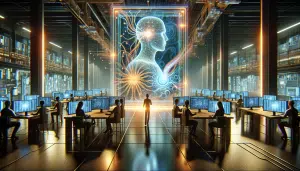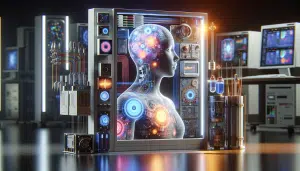Artificial Intelligence Trends You’ll Want to Follow
Ethan Harris October 31, 2025
Artificial intelligence is changing the landscape of tech and science in ways that continue to amaze both experts and everyday users. This guide unpacks trending developments in AI, machine learning, data privacy, automation, and their far-reaching effects, offering insights into what’s influencing workplaces, daily routines, and future possibilities.
The Rise of Generative AI and Everyday Applications
Generative artificial intelligence, which refers to AI models that create new content, is making headlines everywhere. These models can produce human-like text, generate artwork, compose music, and even synthesize code, making them valuable for industries ranging from education to entertainment. Generative AI relies on advanced algorithms trained on massive datasets, learning patterns and nuances that allow it to simulate creativity. Popular examples include large language models, image generators, and applications that help businesses streamline communications or individuals automate repetitive tasks. Many people are now experiencing generative AI without even realizing it, as chatbots power customer support and smart assistants improve daily routines. This technology is becoming more accessible thanks to cloud platforms, expanding its reach and enabling both startups and established enterprises to innovate in ways that were once unthinkable.
The growing integration of generative AI into smartphones, personal computers, and smart devices extends its impact deeply into everyday life. Features like automatic photo enhancement, intelligent email writing, and voice-driven search harness underlying AI models to make complex functions simple for the end user. This seamless blending has led to a surge in productivity tools, creative apps, and accessibility features that were considered futuristic just a short time ago. Even industries like healthcare and journalism are now employing generative models to automate data analysis or enhance storytelling. What stands out is not just the speed of adoption but the sophistication of personalization this technology brings. Families can interact with virtual companions tailored to their interests, and professionals can use AI copilots as creative partners or technical advisors.
While generative AI offers immense advantages, it also presents ethical and practical challenges. Responsible use is a major discussion point, especially as models grow more capable. Some worry about the authenticity of generated content and the risk of misinformation, prompting developers to create safeguards like content filters and watermarking. Industry leaders emphasize transparency, advocating for robust guidelines and increased user awareness. Initiatives that explain how generative AI works help counter misunderstandings, demystifying the role of algorithms and the data behind them. As this trend continues to accelerate, stakeholders—including governments, technology firms, and consumer advocates—are working to ensure generative AI benefits society in a fair and accountable manner. Users are encouraged to stay informed about both the innovations and the responsibilities that come with relying on such powerful technology.
Understanding Machine Learning’s Expanding Role
Machine learning, the engine driving much of modern AI, is a field that allows computers to learn from data and make decisions or predictions without explicit programming. At its core, machine learning uses statistical techniques to uncover patterns and relationships in large datasets. This ability powers personalized recommendations on streaming platforms, automated fraud detection in banking, and even diagnostics tools in medicine. As machine learning algorithms advance, their applications continuously evolve, influencing domains from social media moderation to environmental monitoring. One of the hallmarks of machine learning is its adaptability—models can be retrained with new data, refining their accuracy and making them more relevant for users. This creates a dynamic feedback loop that improves results and drives ongoing innovation across industries (Source: https://ai.nih.gov/resources).
Another defining aspect of machine learning is the diversity in methods and models. Techniques like supervised learning, unsupervised learning, reinforcement learning, and neural networks each serve unique purposes. Supervised learning uses labeled data to teach models specific tasks, while unsupervised learning identifies hidden structures in unlabeled data, revealing insights that may have gone unnoticed. Reinforcement learning, on the other hand, allows models to improve by receiving rewards or penalties for actions taken, similar to how humans learn through experience. Neural networks, inspired by the structure of the brain, are particularly effective for vision and language applications. The flexibility and scale of these approaches enable customization for everything from financial forecasting to speech recognition. With open-source libraries and cloud-based machine learning platforms, more organizations can experiment and deploy these algorithms without starting from scratch (Source: https://www.tensorflow.org/resources/learn-ml).
Machine learning is not just for coders and data scientists. New educational platforms and collaborative tools enable people from all backgrounds to explore this fascinating domain. Interactive interfaces, drag-and-drop data visualizations, and pre-trained models lower the barrier to entry. Teachers and students use them for classroom experiments, while entrepreneurs test ideas before investing deeply in custom code. The democratization of machine learning fosters diversity of thought and accelerates creative problem solving. However, it also underscores the importance of ethics and accountability—users must be aware of algorithmic bias, data privacy, and the importance of transparent model evaluation. As society depends more on machine learning decisions, the need for broader tech literacy and multidisciplinary teamwork grows (Source: https://www.edx.org/learn/machine-learning).
The Explosion of Automation in the Workplace
Automation, driven by artificial intelligence and robotics, is transforming the modern workplace. Manufacturing lines were early adopters of automation, but the latest wave reaches all sectors, including finance, retail, logistics, and even creative industries. AI-powered automation enhances productivity by taking over repetitive tasks, allowing human employees to focus on higher-value activities such as strategy, collaboration, and innovation. From robotic process automation (RPA) in accounting to smart scheduling tools in service industries, automation systems are unlocking efficiency gains and reshaping workforce expectations. These trends are not only changing job roles but also requiring organizations to invest in upskilling and adapting their employees to new ways of working. Forward-looking companies are embedding automation into workflows, using data-driven dashboards to guide daily decision-making and resource allocation (Source: https://www.mckinsey.com/featured-insights/future-of-work/automation-technology-and-the-future-of-work).
Automation has also opened doors for remote and hybrid work models. Smart scheduling, project management platforms, and intelligent assistants make it easier for distributed teams to collaborate asynchronously and deliver consistent results. Automated onboarding processes help new hires get up to speed quickly, while digital workflow tools manage approvals and documentation with minimal manual intervention. This shift encourages a more flexible approach to work and creates opportunities for a diverse workforce. Automation extends beyond routine tasks; it incorporates advanced analytics for supply chain management, customer relationship building, and even AI-powered coaching in leadership development. These advances highlight the versatility of automation and its ability to empower both small businesses and large enterprises in their quest for adaptability and growth.
Despite the clear benefits of automation, concerns persist regarding job displacement and the need for reskilling. Studies suggest that AI and robotics will reshape employment patterns rather than simply eliminating jobs, creating new opportunities in fields like AI maintenance, ethics, and oversight. Policymakers and business leaders encourage transparency and employee involvement in automation initiatives, making the transition smoother for all stakeholders. Ongoing research explores the best ways to balance efficiency gains with economic inclusivity, seeking to build a future where technology augments rather than replaces human talent. The next frontier includes collaborative robots—or cobots—that work alongside people, fostering partnership and driving innovation (Source: https://www.brookings.edu/research/automation-and-artificial-intelligence-how-machines-affect-people-and-places/).
AI, Data Privacy, and Trust in Technology
With the rise of artificial intelligence comes a heightened focus on data privacy and trust. AI systems often rely on vast amounts of personal and organizational data to learn and improve, raising questions about consent, transparency, and security. Headlines about data breaches and algorithmic bias have fueled the public’s desire for stronger protections and clearer regulations. Governments and industry organizations are responding by developing data standards, privacy frameworks, and guidelines for ethical AI use. GDPR in Europe, as well as evolving policies elsewhere, help define how data should be collected, processed, and stored. These measures encourage companies to integrate privacy by design—building safeguards right into products and services instead of treating privacy as an afterthought (Source: https://www.nist.gov/privacy-framework).
Trust in artificial intelligence depends on transparency and explainability. When users understand how AI models reach decisions—whether in loan approval, medical diagnoses, or content recommendations—they can make more informed choices and feel confident in the results. Developers are creating tools that help visualize model logic, address algorithmic bias, and audit AI systems for fairness. As more industries deploy AI-driven solutions, responsible innovation becomes a competitive advantage. Consumers and regulators alike look for organizations that communicate openly about data handling and invite feedback. This two-way dialogue promotes digital literacy and empowers individuals, helping close the gap between cutting-edge technology and everyday understanding.
Public trust also relies on continuous improvement in cybersecurity alongside AI. As technology advances, so do methods used by bad actors to breach defenses and manipulate systems. AI-powered security platforms monitor network activity, identify anomalies, and respond to threats at machine speed, making them invaluable for both enterprises and individuals. Collaboration among governments, academic researchers, and the private sector is essential to staying ahead of emerging risks. Initiatives to standardize protocols, share threat intelligence, and promote secure development practices contribute to a safer digital ecosystem for all. Building trust in artificial intelligence requires ongoing vigilance, proactive engagement, and a culture of responsibility at every level.
Pushing the Boundaries: AI in Science and Discovery
Artificial intelligence is not only transforming business and daily life but also revolutionizing scientific discovery. AI models can analyze complex datasets faster than human researchers, making breakthroughs possible in medicine, climate science, astrophysics, and more. For example, AI-driven protein folding simulations have enhanced our understanding of biology, while climate models powered by machine learning help predict weather patterns with greater accuracy. In astronomy, AI algorithms process massive quantities of telescope data, supporting the discovery of new planets, black holes, and cosmic phenomena. These advances show how digital intelligence can work alongside scientists to solve pressing challenges and answer age-old questions (Source: https://www.nature.com/articles/d41586-020-03409-z).
The collaboration between artificial intelligence and human experts is creating new fields of interdisciplinary research. Teams composed of scientists, engineers, and data analysts merge subject matter expertise with algorithmic insight, opening doors to discoveries that neither could achieve alone. In drug development, for instance, AI shortens the pathway from initial molecule discovery to clinical trials by modeling interactions and side effects more efficiently than traditional methods. This synergy accelerates research cycles and makes real-world impact possible within shorter timeframes. Universities and research institutions are investing in AI labs and joint programs, training the next generation of scientists to leverage digital tools for social good.
These innovations are not just for elite labs. Citizen scientists, students, and hobbyists now use open data and public AI platforms to contribute to research projects or solve local problems. Collaborative platforms invite communities to work together—analyzing air quality, tracking wildlife, or identifying resources in crisis zones. AI democratizes discovery, making scientific exploration more inclusive and responsive to global needs. As computational capacity grows, so does the opportunity for creative problem solving and advancement in every branch of science.
The Future: Where AI, Society, and Ethics Intersect
The trajectory of artificial intelligence will be shaped by how society addresses ethical challenges and sets boundaries for responsible use. Current debates explore not only privacy and bias but also economic and social impacts—from algorithmic decision-making in healthcare to the implications of autonomous vehicles. New fields like AI governance and digital ethics are developing frameworks for oversight, ensuring technology is harnessed in ways that protect human rights and promote fairness. The global nature of innovation in AI adds layers of complexity, as cultural norms and legal requirements vary across borders. Dialogue among technologists, policymakers, and the public is crucial for creating balanced policies that support both growth and accountability (Source: https://aiethics.princeton.edu/resources).
A major question for the future is how to ensure AI complements human values rather than overriding them. Education plays a pivotal role in preparing societies for an AI-driven world—by teaching the next generation critical thinking, digital literacy, and a solid understanding of how algorithms work. Advocacy groups, universities, and tech organizations are collaborating on workshops, courses, and certifications focused on ethical AI practices. These programs provide foundational skills that citizens and workers need to adapt to ever-changing technologies. Accountability is reinforced by industry standards, third-party audits, and transparent reporting.
Ultimately, artificial intelligence is a tool—one with immense promise and inherent risk. Its impact will depend on the collective choices of designers, users, and leaders across the globe. By fostering open dialogue, investing in education, and upholding ethical standards, society can shape an AI future that is inclusive, innovative, and aligned with shared human aspirations. Staying informed, adaptable, and curious ensures that everyone can participate meaningfully in this ongoing technological revolution.
References
1. National Institutes of Health. (n.d.). AI Resources. Retrieved from https://ai.nih.gov/resources
2. TensorFlow. (n.d.). Learn ML. Retrieved from https://www.tensorflow.org/resources/learn-ml
3. edX. (n.d.). Learn Machine Learning. Retrieved from https://www.edx.org/learn/machine-learning
4. McKinsey & Company. (n.d.). Automation Technology and the Future of Work. Retrieved from https://www.mckinsey.com/featured-insights/future-of-work/automation-technology-and-the-future-of-work
5. Nature. (2020). How Artificial Intelligence is Changing Science. Retrieved from https://www.nature.com/articles/d41586-020-03409-z
6. Princeton University Center for Information Technology Policy. (n.d.). AI Ethics Resources. Retrieved from https://aiethics.princeton.edu/resources







